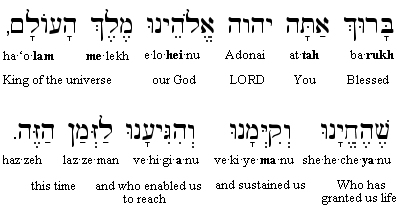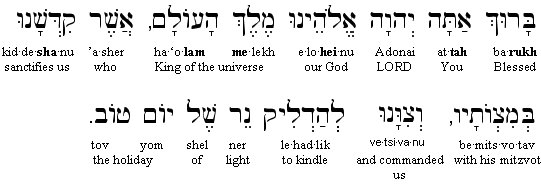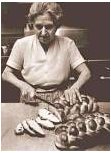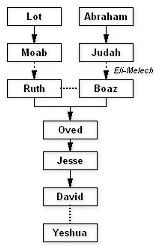|
|
 |
 |
 |
 |
|
A Shavuot Seder -
|
|
|
|
Traditional Blessings for Shavuot...
|
|
|
|
Like all other Jewish holidays, candles are lit at sundown on the eve of the holiday. For example, if Shavuot's first day is on May 30th, the candles should be lit as the sun sets on May 29th...
|
|
|
|
The Yom Tov Blessing
|
|
|
 |
 |
|
On the first night of Shavuot it is considered a mitzvah to light two candles, recite Shehecheyanu, and eat a festive meal with family or friends.
First we light the two holiday candles at our prepared table. Note that unlike Shabbat, we first say the blessing and then light the candles:
|
 |
 |
|
barukh attah Adonai eloheinu melekh ha-olam, asher kideshanu
bemitzvotav ve-tsivanu lehadlik ner shel yom tov.
|
|
|
 |
 |
|
Then, as is customary with all the holidays, we add the following blessing:
|
 |
 |
|
Hebrew Blessing Study Card:
|
 |
 |
|
The traditional HaMotzi blessing is recited before eating bread (or bread stuffs) and is one of the most frequently said of the Hebrew blessings, used for Shabbat, holidays, and other occasions:
|
 |
 |
|
Since the sages identified Shavuot as Z'man Mattan Torateinu, a time that commemorates the giving of the Torah at Mount Sinai, activities and customs about receiving the Torah are prevalent during this time. According to midrash, the soul of every Jew was present in the first generation of Israel that left Egypt, and therefore every Jew was "present" at Sinai when the covenant was given. We are commanded to consider ourselves personally involved at Sinai. Therefore, on Shavuot Jews reaffirm their commitment to the Mosaic covenant and the Jewish way of life. During synagogue services, everyone stands as the Ten Commandments are recited, and everyone ratifies them with kol asher-dibber Adonai na'aseh v'nishmah:
|
 |
 |
|
Tikkun Leil Shavuot
|
 |
 |
|
After the celebrating kiddush and enjoying the holiday meal on the night of Shavuot, it is customary to stay up throughout the rest of the night reading selections from the entire Torah (and portions of the Talmud) until sunrise. This custom, called tikkun leil shavuot (ū¬ų╝ų┤ū¦ų╝ūĢų╝ū¤ ū£ųĄūÖū£ ū®ūüųĖūæūĢų╝ūóūĢų╣ū¬), "rectification for Shavuot Night," is meant to repair (tikkun) the mistake of being unprepared to receive the Torah on the morning of Sivan 6. "We remain awake to show that, unlike the situation of our heavy-lidded ancestors at Sinai, there is no need to bring us to our senses; we are ready to receive Torah." The anthology of passages from the Tanakh and Talmud is called a (Shavuot) "Tikkun."
It should be noted that this custom is based primarily on farily recent Kabbalistic tradition, since some of the Jewish mystics apparently believed that the heavens were "open" to receive the thoughts, study, and prayers of those who remain awake on the anniversary of the giving of the Torah at Sinai, whereas other mystics likened the vigil to the hours of anticipation or preparation prior to a wedding...
|
 |
 |
|
Megillat Ruth - the Book of Ruth
|
|
|
 |
 |
|
Megillat Rut, the Book of Ruth, is read in the synagogue at this time, since the events recounted took place during the time of the spring harvest (linking it to the agricultural aspect of Shavuot), and Ruth is a picture of willing acceptance of a Jewish lifestyle (linking it to the events of Sinai).
|
|
 |
 |
|
Ruth was a Moabitess, a non-Jew who converted to the Jewish faith and became part of the lineage of King David and the Messiah Yeshua through the love of a goel, or kinsman redeemer:
|
 |
 |
|
The Advent of Ruach HaKodesh
|
 |
 |
|
During Temple times, Shavuot was observed an agricultural festival, though the sages also recognized it as the time to commemorate the giving of the Torah at Mount Sinai. As one of the three pilgrimage festivals, Jews from all over the world would come to Jerusalem to celebrate and reaffirm their commitment to the covenant of Moses.
And such was the practice when God delivered the Substance of which the festival of Shavuot was merely a "type and a shadow." For the Brit Chadashah reveals that Shavuot is the climax of God's plan for our deliverance through Yeshua, the true Lamb of God (Seh Elohim). The countdown to Shavuot represents the giving of the anticipated New Covenant to mankind, since it was on this very day that the Ruach HaKodesh (Holy Spirit) was given to form the Church of God.

With a touch of divine irony, on the very day that Jews from around the world gathered in Jerusalem to reaffirm their commitment to the covenant of Moses, the Holy Spirit descended upon Israel to offer the promise of the New Covenant to all who will believe (see Acts 2:1-42). This new covenant makes Torah a matter of the heart, written by the God's Spirit, that yields a life fruitful in the praise of God.
Just as the resurrection of Yeshua represents the Firstfruits of those who have died (1 Cor 15:20) and fulfills the prophetic ritual of the waving of the omer on the festival of First Fruits, so the giving of the Holy Spirit to the church fulfills the wave offering of the wheat loaves on the day of Shavuot.
Shavuot marks the time when God entered into covenant with the Jewish nation. During the first Shavuot at Sinai, God instituted the Mosaic covenant and gave the Torah in written form, but during the Shavuot at Zion, after the resurrection of Yeshua, God established the New Covenant when He wrote the Torah on the hearts of Yeshua's followers.
- Shavuot at Mount Sinai is sometimes considered the day on which Judaism was born. Shavuot in Jerusalem (Mount Zion) is the day on which the church was born when the Holy Spirit was poured out upon the followers of the Mashiach.
- At Mount Sinai the Ten Commandments were written on tablets of stone by the "finger of God" (Exodus 31:18), but at Mount Zion, the Torah is written on tables of the heart by the Spirit of God (2 Cor 3:3; Hebrews 8:10).
- Just as the Israelites were affirmed as God's chosen people on Shavuot with the giving of the Torah, so the Church was affirmed as God's chosen people at Shavuot after the Mashiach's ascension into heaven as the Mediator of a Better Covenant (Hebrews 8:6). The 3,000 that were added to the church that day were firstfruits of the redeemed people of God.
- In the Jewish tradition, Shavuot is compared to a wedding, for it was on Shavuot that the covenant between God and the Jewish People was sealed at Mount Sinai. The church is called Kallat Mashiach - the Bride of Messiah (Rev 21:2,9), and we eagerly await the marriage supper to come (Rev 19:9).
|
 |
|
|
 |
|













